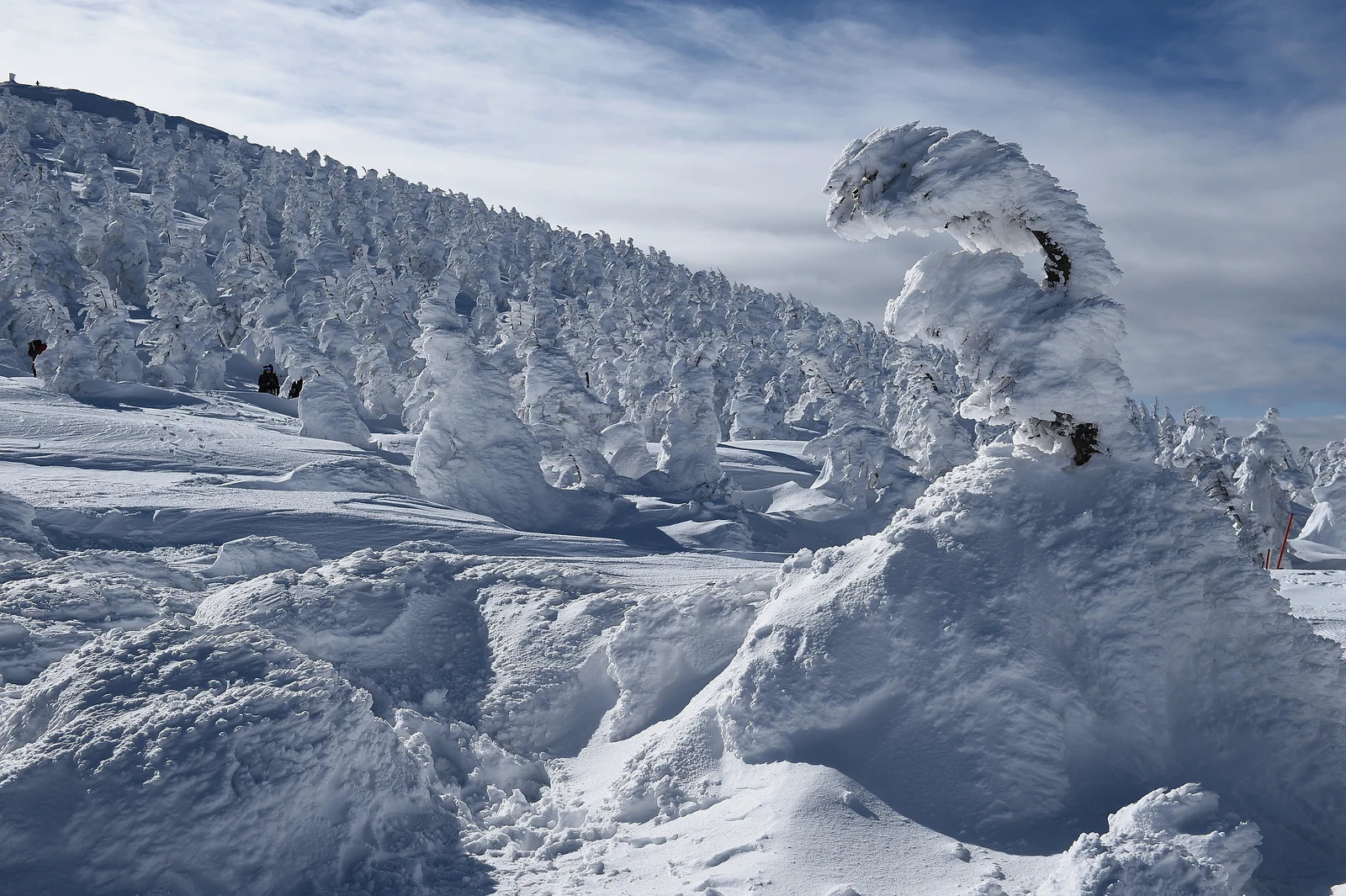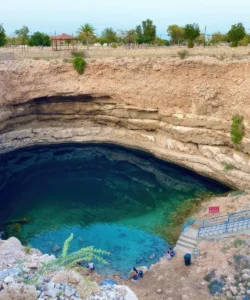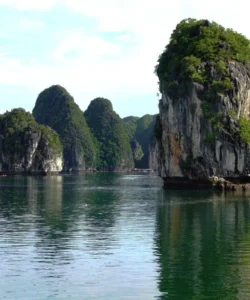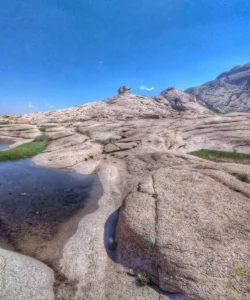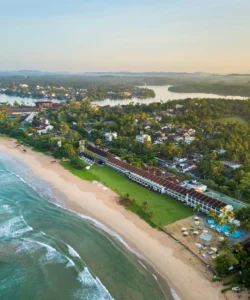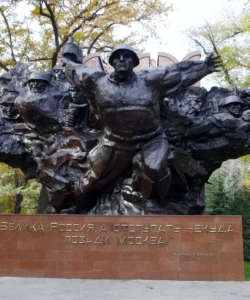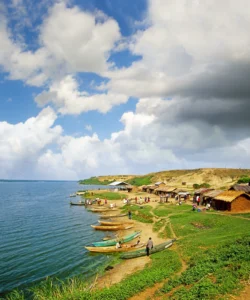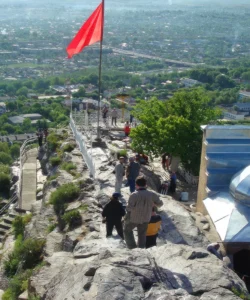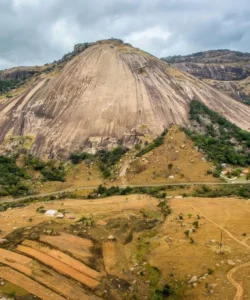Prepare to enter a truly fantastical “Wonder” at Zao Snow Monsters, where an otherworldly landscape of frozen giants comes to life each winter.
![]()
Name: Zao Snow Monsters (蔵王の樹氷 – Zao no Juhyo), also known as “Ice Monsters” or “Shrimp Tails.”
Address: Zao Onsen, Yamagata City, Yamagata Prefecture, Japan (The specific formations are on the upper slopes of Mount Zao, accessible from Zao Onsen Ski Resort).
How to get there:
The Zao Snow Monsters are located on the slopes of Mount Zao, which straddles the border of Yamagata and Miyagi Prefectures. The most common and accessible viewing point is from the Yamagata Prefecture side, based at Zao Onsen.
- To Zao Onsen (Starting Point):
- By Train & Bus (Most Common):
- From Tokyo Station: Take the Yamagata Shinkansen (Tsubasa) to Yamagata Station (approx. 2.5 to 3.5 hours).
- From Yamagata Station: Take a local bus to Zao Onsen Bus Terminal (approx. 40 minutes). Buses run frequently.
- From Sendai Station (Miyagi Prefecture): Take the JR Senzan Line to Yamagata Station (approx. 75 minutes), then transfer to the bus for Zao Onsen. Alternatively, there are direct buses from Sendai Station to Zao Onsen Bus Terminal (approx. 85 minutes, reservations often required).
- From Yamagata Airport: Take the Zao Liner bus to Zao Onsen (approx. 1 hour, reservation might be required).
- By Train & Bus (Most Common):
- To the Snow Monster Fields (from Zao Onsen):
- Once at Zao Onsen, walk about 15 minutes (or take a short taxi/shuttle) to the Zao Ropeway Sanroku Station (蔵王ロープウェイ山麓駅).
- Take the Zao Ropeway Sanroku Line to Juhyo Kogen Station.
- Transfer to the Zao Ropeway Sancho Line to Jizo Sancho Station (地蔵山頂駅). The snow monster fields are located around this upper station.
- The ropeway ride itself offers magnificent views as you ascend over the transforming landscape.
- Important Note: The snow monsters are a winter phenomenon, typically best seen from late January to mid-March, with their peak formation in mid-February. The ropeway operates during this period, but check schedules, especially for night illuminations.
Landscape and Architecture:
The “landscape and architecture” of the Zao Snow Monsters are entirely natural, formed by a unique combination of extreme winter weather and specific tree types.
- Juhyo (樹氷) – The Snow Monsters: These are not actual creatures but Maries’ fir trees (Aomori Todomatsu), an evergreen conifer, found in the high-altitude subalpine regions of Mount Zao. During winter:
- Harsh Siberian winds carry supercooled water droplets across the Sea of Japan.
- These droplets collide with the fir trees and freeze instantly, forming layers of rime ice.
- Heavy snowfall then accumulates on these ice-covered branches.
- This continuous cycle of freezing rime and snow accumulation, combined with the strong winds, gradually transforms the trees into bizarre, towering, and often eerie shapes resembling monsters, ghosts, or giant shrimp tails.
- Vast Snow-Covered Slopes: The snow monsters are situated on the extensive, snow-covered slopes of the Zao Onsen Ski Resort, which offers a wide network of ski runs winding through the “monster” fields.
- Panoramic Mountain Views: From the summit areas, particularly around Jizo Sancho Station, visitors can enjoy expansive panoramic views of the surrounding snow-clad mountains.
- Illuminations: In the evenings during peak season, the snow monsters are illuminated with various colored lights, transforming the landscape into a psychedelic and otherworldly spectacle.
- Jizo-son Statue: Near Jizo Sancho Station, there’s a stone statue of Jizo Bodhisattva, often partially buried by the snow, which adds to the mystical atmosphere.
- Ski Resort Infrastructure: While the monsters are natural, the “architecture” that facilitates viewing includes the ropeways, observation decks, and warming huts at the summit, allowing both skiers and non-skiers to experience the phenomenon.
What makes it famous:
The Zao Snow Monsters are famous for several compelling reasons:
- Unique Natural Phenomenon: The juhyo are a rare sight, occurring only in a few specific locations in Japan (and even globally) where the exact combination of specific tree species, freezing temperatures, high humidity, and consistent strong winds creates these massive, distinct formations. Zao is considered one of the best places to witness them.
- Otherworldly Appearance: The “monstrous” and surreal shapes of the snow-covered trees are incredibly striking and unlike anything else, captivating the imagination.
- Magical Night Illuminations: The colorful light-up of the snow monsters at night creates a truly unforgettable and ethereal experience, making them appear even more fantastical.
- Skiing Among Monsters: Zao Onsen is also a major ski resort, offering the unique opportunity to ski or snowboard directly through forests of these snow monsters, which is a dream for many winter sports enthusiasts.
- Accessible Wilderness: Despite their remote, high-altitude formation, the snow monsters are remarkably accessible via modern ropeways, allowing a wide range of visitors (including non-skiers) to experience them.
- Photographic Hotspot: The dramatic and unique scenery makes for stunning photographs, contributing to its viral popularity.
Differences from some other wonders:
- Ephemeral and Climatically Dependent: Unlike permanent structures (e.g., temples, bridges) or year-round natural formations (e.g., gorges, lakes), the Zao Snow Monsters are an entirely temporary wonder, existing only during a specific window in winter and dependent on precise weather conditions. This makes witnessing them a special, almost fleeting privilege.
- Nature’s “Sculptures” (Organic Architecture): While some wonders are natural landscapes, the snow monsters are unique in being natural “sculptures” or “organic architecture” formed by the interaction of specific trees and weather. They are not simply a static landscape but evolving, monstrous forms.
- Integration with Winter Sports: While many natural wonders are for pure sightseeing, the Zao Snow Monsters are inextricably linked with a major ski resort, offering a dynamic active experience (skiing/snowboarding) within the natural wonder, which is a rare combination.
- Dual Appeal (Day & Night): The snow monsters offer distinct “wonder” experiences during the day (clear, massive forms) and at night (illuminated, mystical forms), providing a comprehensive and captivating visit across different times.
- Focus on a Micro-Climate Phenomenon: Its fame isn’t for a vast geographical feature (like a mountain range itself) but for a very specific, localized meteorological and botanical phenomenon that produces these unique shapes, making it a highly specialized natural wonder.
